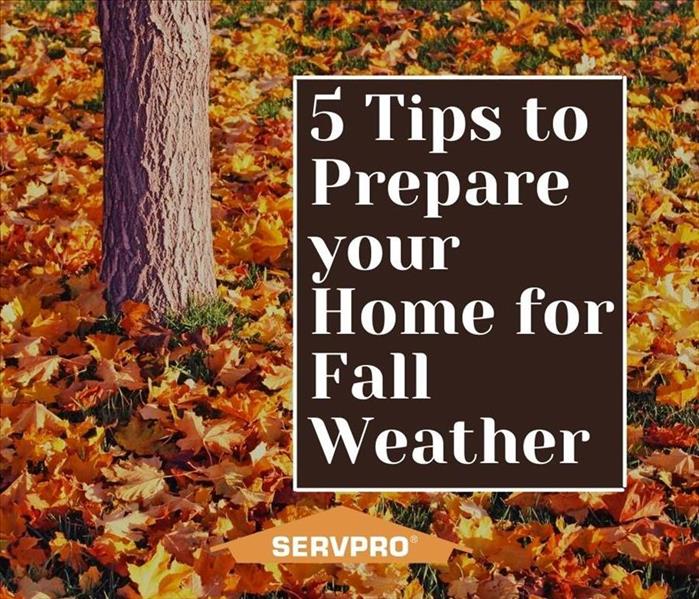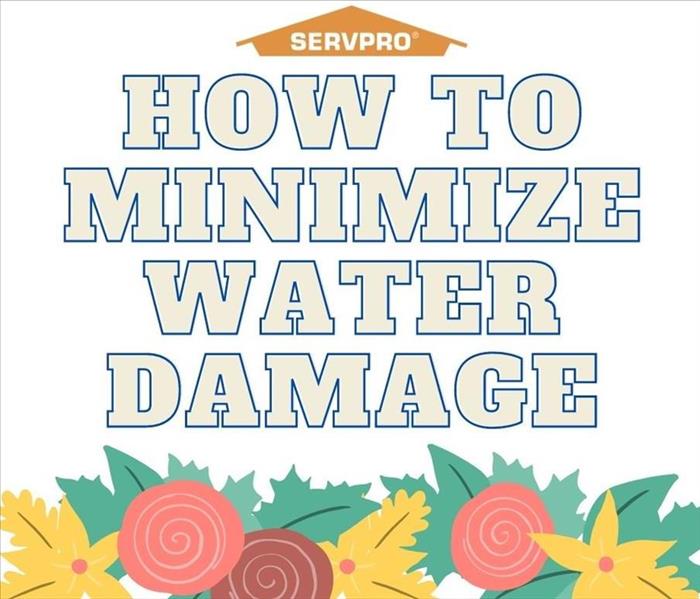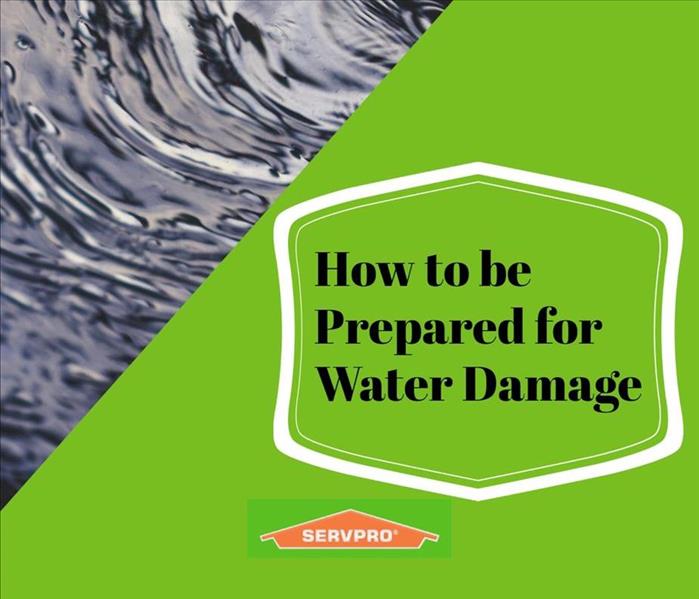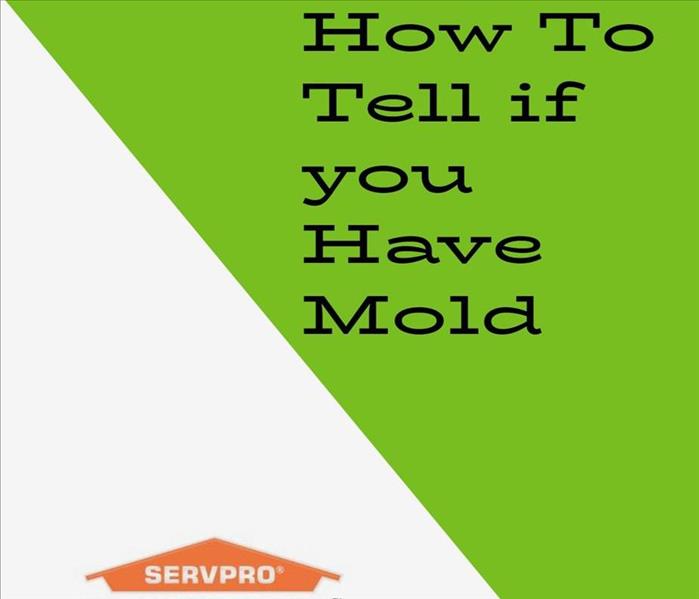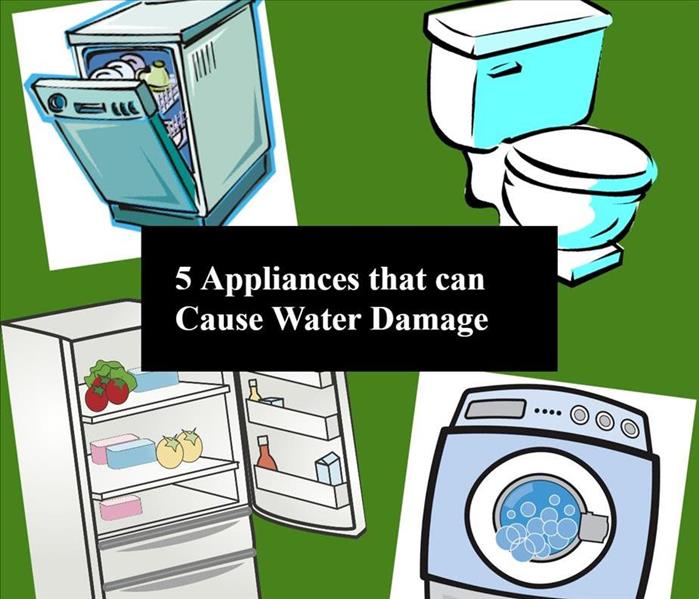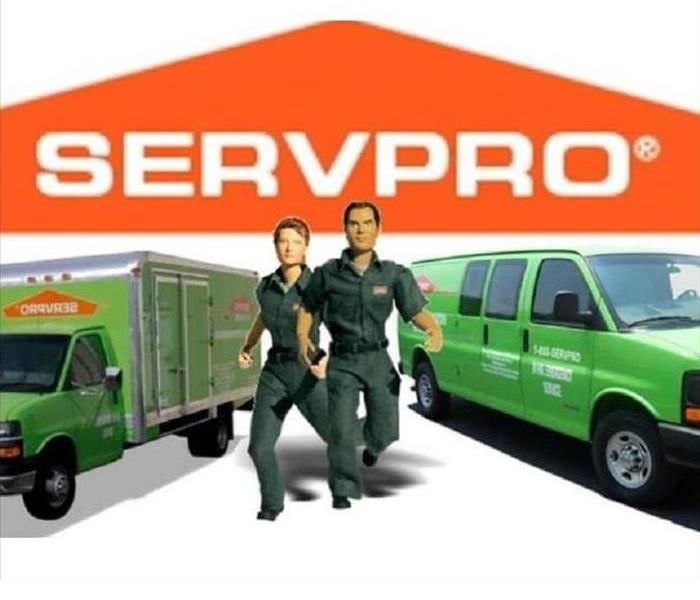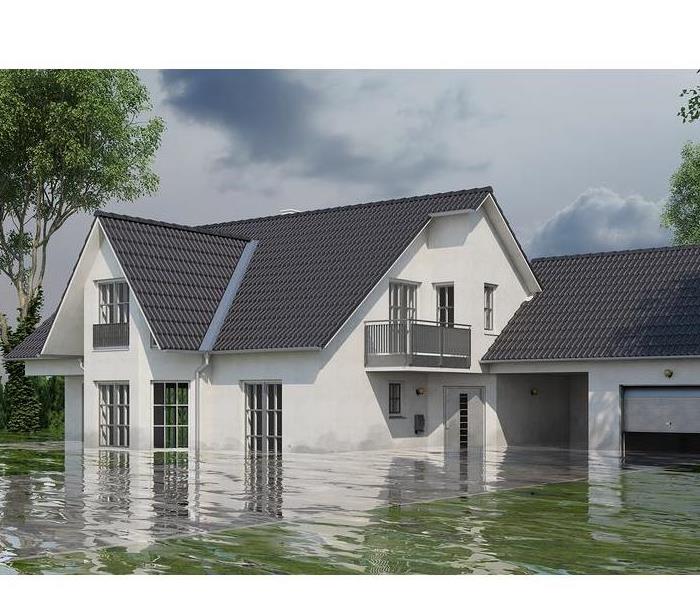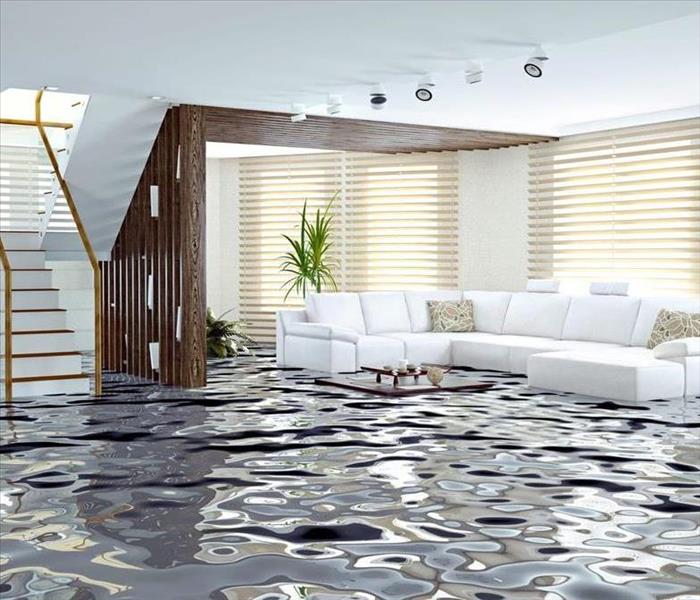Archived Water Damage Blog Posts
5 Tips to Prepare your Home for Fall Weather
10/21/2021 (Permalink)
Fall is our favorite season at SERVPRO of Norridge/Harwood Heights and now that the weather is getting cooler, it’s time to talk about some recommendations on how to get your home ready for fall.
- Clean your gutters- This is super important. When your gutters become clogged, they can cause damage in many different places in your home, like your foundation, your basement and your walls/ceiling. If this situation is rectified before winter, it can cause ice dams on the roof which can lead to more water damage. Check out our blog on ice dams here.
- Check for any drafts in your home- Weatherstripping your windows and doors can help prevent heat loss. Heat loss through windows is responsible for 25-30% of heating energy use.
- Change your filters- If your air filter is dirty, it’s harder for your blower fan in your HVAC system to push air, while also spreading dust, pollen and other small particles.
- Bring any outdoor furniture inside- In order to keep any outdoor furniture in its best condition, it's important to store it inside or under a tarp.
- Clean your fireplace/chimney- Your fireplace and chimney should be cleaned and inspected every 50 burns to prevent chimney fires.
These are a few of our favorite tips for getting your home ready for fall. What other recommendations do you have when it comes to preparing for fall?
National Preparedness Month- Make a Kit
9/10/2021 (Permalink)
The second week of National Preparedness is all about building a kit. In case of an emergency, such as a flood, it’s important to have vital items that can assist you and your family in any event. Below, I’ve made a list of the most important items to put in your families’ emergency kit as suggested by Ready.gov.
- Water- You should have one gallon per person for several days.
- Food- It’s a good idea to have three days worth of nonperishable foods.
- Battery powered radio- In case of an emergency, it’s important to be able to know what’s going on and what experts are recommending.
- Flashlights
- First Aid Kit
- Extra Batteries
- Whistle- A whistle can be used to signal help if you or your family is stuck
- Prescription Medicine
- Pet food
- Important family documents (birth certificates, social security cards, any insurance information, etc.)
There are more items to consider to add to your Emergency Kit can be found on Ready.gov. Remember to keep the kit in a designated area so you can find it quickly if needed. Make sure to keep it in a dry, cool place.
How to Minimize Water Damage
5/11/2021 (Permalink)
Spring is the wettest time of year and though the showers bring flowers, it can also cause water damage. No matter how water damage occurs, whether by flooding/rain or a plumbing issue, it can be very expensive. The average cost of water damage restoration is over $3,000. To protect yourself and your home from water damage, first and foremost, it’s important to do any preventative measures.
The best tool against leaks and floods, is being ready beforehand. Below, I’ve compiled a list of a few tips that can help you reduce your risk of water damage in/around your home.
- Keep gutters and downspouts clear
- Check appliances for leaks regularly and fix any problems promptly
- When replacing appliances, replace the hose as well
- Consider installing water detection devices near your water heater, sump pump, washing machines or any other device at risk for leaks
- Keep a watchful eye over your water bills. A spike in the usage can give away a mystery leak
If you have noticed water damage in your home, the best plan of action is to clean it promptly. Water damage can lead to mold growth, which can cause additional damage and produce a smell. After several hours, some flooring and items will be unsalvageable if they aren’t properly dried. Here are some tips for what to do after discovering a flood or water damage in your home.
- First, shut off the water source. Find the shut off valve for the fixture or the pipe causing the leak and shut it off. If you cannot find or reach these shut offs, shut off the main water valve for your home.
- Do what you can to limit damage:use buckets or tarps to intercept the water. Move any furniture away from the wet area.
- Call your insurance company to begin a claim.
- Call SERVPRO for restoration help.
All About Ice Dams
1/27/2021 (Permalink)
What is an Ice Dam?
-An ice dam is a ridge of ice that forms on the edge of the roof and prevents any melting snow from draining properly off the roof. If the water cannot drain properly, it can back up into the house and cause damage to walls, ceilings, insulation and other areas.
What happens if the water seeps into the house?
-It is likely the water will cause mold or mildew to grow, which can be damaging to your health.
Why do ice dams form?
-According to the University of Minnesota, nonuniform roof surface temperatures lead to ice dams. Heating from the house escapes through the roof, which causes the melting of snow on certain parts of the roof that are above 32F, but as it flows down, it reaches a place on the roof where the temperature is below 32F and freezes again. The water above the dam cannot flow down, thus it flows into cracks and openings into the home.
How do we prevent ice dams?
-Make sure your ceiling is airtight, so no warm, moist air can flow into the attic space and make its way to the roof. Consider increasing ceiling/roof insulation to cut down on heat loss by conduction. Insulate attic access doors and remove any attic heat sources.
How to be Prepared for Water Damage
9/2/2020 (Permalink)
Happy National Preparedness Month!
We know things happen in a blink of an eye, which is why we’re available all day, every day. The best thing you can do in those situations is to have a plan in case a water emergency happens. I’ll be listing some important things you can add to your plan in case you experience a water emergency at your home or business.
- First things first, protect yourself and your possessions. Try to shut off any electricity to an affected area by switching off the circuit breaker or unplugging any devices. Also, rescue any important documents or electronics.
- Next, figure out the source of the water and try to stop the water from increasing any damage. The most likely source is a burst pipe or hot water tank leak. Use your shut off valve. If the leak is on the ceiling, call in a professional to locate the source. Also, look out for mold, which can be identified by a musty smell or discolored ceilings/walls.
- After trying to limit the damage, call your insurance provider and figure out any steps you need to take. You should also have a claims adjuster come out and document the damage and estimate the cost of repairs. Take photos of the damage and any affected valuables.
- Start the process of drying out your property. You could hang up rugs and move any furniture from the affected area. Also, use fans or dehumidifiers to dry wet areas.
Contact us today for your water damage restoration needs
How to Tell if you have a Mold Problem in your Home.
7/29/2020 (Permalink)
Mold can cause many different problems in your home and sometimes it isn’t super simple to figure out if you may have a mold issue. Check out these telltale ways to discover if you may have a mold infestation.
You can visibly see mold
The easiest way to tell if you have mold is by visibly seeing it. Also, if there is a lot of visible mold, that can indicate that the underlying problem is larger. While you may be tempted to just scrub the area of mold, this actually will not remove all the mold. The best thing you can do is call a mold remediation company, like SERVPRO of Norridge/Harwood Heights.
You could be experiencing health effects
While you can experience health effects from many different causes, mold can be one of those causes that can be easily overlooked. If you want to eliminate mold as a culprit, leave your home for a few days and see if your symptoms stop.
You can notice a musty odor
There are many different types of mold, and because of this, the smell of molds may vary. However, if you notice a musty smell that isn’t common to your home or building, that may signify that there is mold growing.
You have a history of flooding
After a flood, you may keep an eye on the location of the flood to see if you notice any mold growth, but mold can grow long after the flood occurs. Most mold isn’t visible until a few weeks after the initial flooding.
If you have mold in your home, make calling SERVPRO of Norridge/Harwood Heights your next step!
5 Household Appliances that Can Cause Water Damage
7/16/2020 (Permalink)
When thinking about areas in your home that are prone to water damage, you should think about these 5 appliances that can cause the most leaks in your home.
1.Refrigerator- In terms of leaking coming from a refrigerator, there are two likely culprits. The first being a blocked defrost drain. This drain can be blocked with food particles or other debris and can eventually lead to water leaking from the refrigerator. Make sure to check this area of the refrigerator if you are experiencing a leak. Also, the water supply line that feeds water to your ice machine could leak. Make sure to check connections.
2.Dishwasher- Another appliance that is prone to leaks is a dishwasher. While there are many different mechanical problems that could cause leaks, like a faulty float switch or a clogged drain, a common leak from a dishwasher is when the wrong detergent or too much detergent is used.
3.Washing Machine- Washing machines have many things that could cause leaks. If you notice a leak coming from your washing machine, make sure to check all connections (inlet and hose) and also the floor drain, which could be clogged. Check your owners manual, unplug the washing machine and turn off the water main. Troubleshoot all possible areas where the leak could be coming from.
4. Water Heaters- The main leaks relating to water heaters are due to a malfunctioning temperature and pressure relief valve, a leaky plumbing connection or corrosion in the water tank itself. You can test the valve by flushing water through to clear any debris. If corrosion is the problem, you will need to replace the water heater.
5.Toilets- Toilets overflow because they have clogged drain or because the float is malfunctioning, which allows too much water into the tank. If plunging doesn’t solve the problem, the problem may be in the pipes outside, which would require a professional plumber.
If you have experienced water damage in your home, please contact SERVPRO of Norridge/Harwood Heights at 1-708-453-3655.
How to Avoid Household Water Damage
9/24/2019 (Permalink)
Last week, The Chicago Tribune featured an awesome article about water damage and how to avoid it. First and foremost, water losses are six times more likely to cause suffering to homeowners than any theft. Many people actively protect against theft, but not as many protect themselves against water losses.
The leading cause of household water damage is appliance issues or plumbing failures. These losses aren’t cheap either. According to the article, “water damage accounts for over a billion dollars in insured losses for homeowners and renters”. Each loss averages more than $10,000 as well. Insurance won’t always cover all losses. Also, if the insurance company determines that the issue should have been detected and fixed by the homeowner, like a leaky roof. However, a sudden water issue, like a washing machine hose bursting, would be covered by insurance.
The article offers different ways to prepare yourself for water losses before they happen, which could lessen any damage.
- Locate the main shut off- The article says that not only adults, but also older children should know where the main shut off is and how to turn it off properly.
- Regularly check supply lines- Look for hoses that lead to your appliances and consider changing any rubber hoses to metal, braided metal versions. Check for any leaks in the lines to these appliances as well.
- Don’t run any water appliances overnight or when you’re not at home- While you’re sleeping, you’re not monitoring your appliances and, according to the article, a bust hose can pump 600 gallons of water an hour into your house. They also recommend that you shut off your water valves before heading on vacation.
- Stay on top of home maintenance- This includes any gutters, roof issues, and any locations inside your home that have water, like tubs and showers.
- Install alerts- There are detectors that can be installed that can monitor your water usage for any anomalies. These can be used through different phone apps, which can facilitate monitoring.
SERVPRO of Norridge/Harwood Heights is proud to bring you tips to avoid water damage. If you have experienced water damage, please call at 1-708-453-3655!
What to Expect From a Water Damage Company, Like SERVPRO
9/16/2019 (Permalink)
Best Pick Reports recently released their Chicagoland area report on what you should ask of a company that handles water damage SERVPRO of Norridge/Harwood Heights is proud to promote and participate in these practices.
Water Emergency
When you experience a water loss, like a flood or burst pipe, it's important to first determine what the source of the water is. Shut off the main water valve, if the source of the water is due to a pipe. An expert, like SERVPRO of Norridge/Harwood Heights, can begin to survey any damage and write an estimate that would list the expected costs of water extraction and drying procedures.
The Cleanup Process
First thing you can expect your restoration company, like SERVPRO of Norridge/Harwood Heights, to do is remove any standing water. Our crew can then determine if there is any areas that could hold any trapped water and identify any equipment that would help promote a quick and thorough drying process.
Another important thing to note is that materials, such as drywall and wood, can show no visible signs of water retention, but can still have water under the surface layer. SERVPRO of Norridge/Harwood Heights uses special equipment, such as dehumidifiers and air movers that can completely dry any wet or damp areas. We monitor these areas with moisture meters to ensure everything is drying as it should.
Water damage can be stressful. To make it less stressful, you should put your trust in a company that can accurately handle your water damage, like SERVPRO of Norridge/Harwood Heights.
The Different Types of Floodwaters
8/11/2019 (Permalink)
Floodwaters can cause major damage in your home or business. After a flood, it's important to immediately begin cleanup in order to avoid creating even more damage, like mold growth.
When assessing a flood, it's important to understand which type of floodwater has affected the home or business. There are three separate kinds of floodwaters, and they're classified by the water source, its contents and its history.
- Clean water- This is water that does not pose an immediate health risk. This water does not have contaminants and could include things like toilet holding tanks or malfunctioning appliances amongst others like rain or snow melt.
- Gray water-These waters could cause a health risk, because they could contain biological or chemical contaminants. This could include discharge from a dishwasher or a laundry machine or water from sinks or showers.
- Black water-This is a definite health risk. These have definite contaminants with it. The floodwaters contain soil and sewage and the microbes will almost always cause illnesses.
With these different flood waters, it's important that they are a taken care of quickly, because even clean water can turn into grey water in as little as 48 hours.
SERVPRO of Norridge/Harwood Heights can clean up your home after flood damage quickly and effectively.
Helpful Tips for New Homeowners in the Norridge/Harwood Heights Area
7/8/2019 (Permalink)
You've just bought your first house! Congratulations! Now, it's time to make sure you're taking care of it to keep it in the best condition as possible. Below are tips to avoid a water disaster in your new home.
- Check your water heater for leaks- If you notice leaking from your water heater, check to see if it is a valve or the tank. If the water is coming from the tank, you should replace it immediately. A leaky tank can burst at anytime, causing an instant flood.
- Shut off water before a vacation-When you're away, you aren't worrying about what could be happening at home, but you could come home to a complete disaster, causing you thousands of dollars in water damage.
- Locate your main water shut off valve- This can help you control your water that is coming into your house to control a flooding situation.
SERVPRO of Norridge/Harwood Heights is proud to provide water restoration to our community. Please call us at (708) 453-3655 if you have experienced any water damage.
Water Damage Timeline
6/10/2019 (Permalink)
Water damage can cause serious problems to your home or business, but the faster the problem is found, the faster you can call SERVPRO of Norridge/Harwood Heights to begin the restoration and limit the damage.
Within Minutes
- Water quickly spreads throughout your property, saturating everything in its path.
- Water is absorbed into walls, floors, upholstery, and belongings.
- Furniture finishes may bleed, causing permanent staining on carpets.
- Photographs, books, and other paper goods start to swell and warp.
Hours 1 - 24:
- Drywall begins to swell and break down.
- Metal surfaces begin to tarnish.
- Furniture begins to swell and crack.
- Dyes and inks from cloth and paper goods spread and stain.
- A musty odor appears.
48 Hours to 1 Week:
- Mold and mildew may grow and spread.
- Doors, windows, and studs swell and warp.
- Metal begins to rust and corrode.
- Furniture warps and shows signs of mold.
- Paint begins to blister.
- Wood flooring swells and warps.
- Serious biohazard contamination is possible.
More Than 1 Week:
- Restoration time and cost increase dramatically; replacing contaminated materials and structural rebuilding may be extensive.
- Structural safety, mold growth, and biohazard
- Structural safety, mold growth, and biohazard contaminants pose serious risks to occupants.
As shown in the timeline, the damage can progress quickly. The best thing for you to do when discovering water damage is call SERVPRO of Norridge/Harwood Heights to begin the restoration so you will not have to experience the costly damage that can be inflicted over time.
If you currently have water damage, call us at 1-708-453-3655
Flooding Tips
6/3/2019 (Permalink)
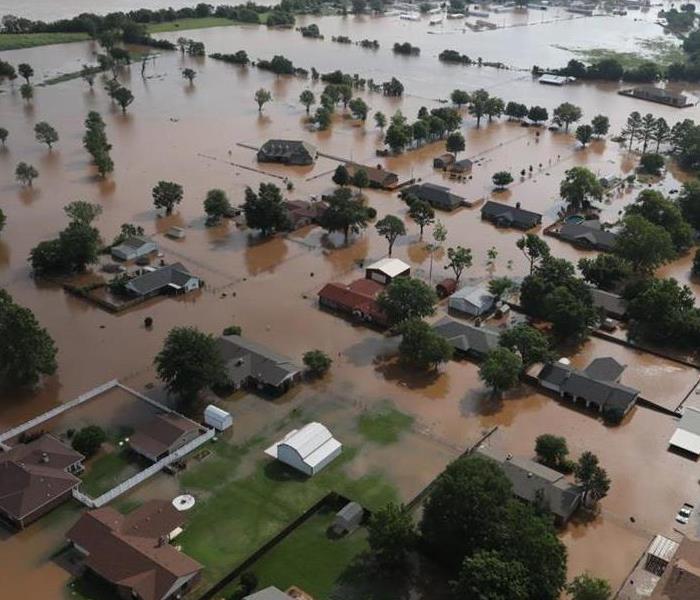 Flooding can be catastrophic, so it's good to be prepared.
Flooding can be catastrophic, so it's good to be prepared.
Floods are common throughout the summer months due to severe storms in the Chicagoland area. With this, it's important to be ready at any time for floods by following these tips.
Advance Preparation
We recommend creating a Emergency Profile with the SERVPRO Emergency Ready Profile. Our app can store all of the important information about your property and emergency response information in one place making it easy to report any damage from your smart phone, tablet or computer.
Watch for Pooling Water
Take note of all places that water may pool on your property and direct this water away from buildings. Make sure gutters are clean and are directing water as directed.
Maintain Sump Pump
If you have a sump pump, make sure it is operating correctly and efficiently before water starts to rise.
Raise Storage
Raise items of the floor onto shelves or pallets to keep them away from possible water damage. In some cases, a few inches can make a huge difference.
Keep Storm Drains Clear
If you see water gathering near a storm drain in your neighborhood, it may be blocked with debris. Clearing the debris away from the drain will help water flow away from your property into the drain.
Act Fast
When you experience a flood, it's important to act fast to dry out any wet items in the property including walls and floors. Call SERVPRO of Norridge/Harwood Heights at 1-708-453-3655 to extract water and mitigate any mold growth. We have the experience and training to make it "Like it never even happened."
The Vulnerable Basement
4/17/2018 (Permalink)
Basements are prone to floods because water may flow down into them. They also may have an increased hydrostatic pressure exerted upon them when the surrounding ground is saturated. Recognizing that elevation is the best form of mitigation, there are a number of additional measures business owners can take to reduce the likelihood and scope of basement flood damage.
- Thoroughly inspect your basement and the surrounding property for evidence of water entry and sources of water flow and leakage.
- Correct potential problems—for example, extend and redirect downspouts, re-grade sloping landscape, and caulk any interior wall cracks.
- Basement walls should be designed to resist hydrostatic pressure.
- Use flood-resistant materials where possible, including floor coverings, wall coverings, and wall insulation. Most flood-resistant materials can withstand direct contact with water for at least 72 hours without being significantly damaged.
- Do not store valuable equipment, documents, or inventory in any crawlspace or basement where flooding is possible.
Flood Insurance
4/17/2018 (Permalink)
The best way to learn more about flood insurance benefits, costs, and options is to contact your insurance agent. Finally, take steps now so you can quickly resume operations should a flood or other hazard damage your property. Although flood insurance may cover losses to your structure and contents, many businesses that are severely damaged never fully recover financially due to the loss of management focus, employees, and market share. Planning tools helps small- and mid-sized businesses resume their critical business operations and work processes and deliver the goods and services expected by customers or clients–consider it a vital part of your flood preparation planning and practice.
SERVPRO of Norridge/Harwood Hts. works with all insurance companies to insure prompt response to flood situations.
Protecting Your Home Tips From the Red Cross
4/17/2018 (Permalink)
- If you live in a floodplain, elevate and reinforce your home to make damage less likely during a flood.
- Check with a professional to:
- Raise your furnace, water heater, and electric panel to floors that are less likely to be flooded. An undamaged water heater may be your best source of fresh water after a flood.
- Install check valves in plumbing to prevent floodwater from backing up into the drains of your home. (As a last resort, when floods threaten, use large corks or stoppers to plug showers, tubs, or basins.)
- Construct barriers such as levees, berms, and flood walls to stop floodwater from entering the building (if permitted by local building codes).
- Seal walls in basements with waterproofing compounds to avoid seepage through cracks.
- Use sand bags when flooding is expected:
- It takes two people about one hour to fill and place 100 sandbags, creating a wall one foot high and 20 feet long.
- Make sure you have enough sand, burlap or plastic bags, shovels, strong helpers, and time to place them properly.
- If a flood is expected, some communities will offer free sandbags to residents. Be sure to watch or listen to the news so you can access these resources.
How Floodwaters Affect Your Home
4/17/2018 (Permalink)
Once contents and debris have been cleared, the next step is to get the water out of the ceilings and walls. How you drain and dry your ceilings and walls depends on what they are made of. Wallboard. Most ceilings and walls are covered with wallboard, especially in newer homes. Wallboard will act like a sponge, drawing water up above the flood level. It becomes very fragile if it stays wet for long and will fall apart when bumped. When the wallboard finally dries, there will still be mud and contaminants dried inside. Wallboard that has been soaked by floodwater presents a permanent health hazard. Therefore, this book recommends that you throw out flooded wallboard. On the other hand, if the wallboard was soaked by clean rainwater, it can be dried in place with plenty of fresh air moving through the area. Plaster. Plaster will survive a flood better than wallboard. It should not have to be replaced but it will take a very long time to dry. Sometimes the plaster will separate from the wood laths as it dries. Then the wall will have to be removed and replaced. Insulation. There are 3 main types of insulation and each reacts differently to floodwaters. Styrofoam survives best; it may only need to be hosed off. Fiberglass batts should be discarded if they are muddy. If soaked by clean rainwater, remove them so the rest of the wall can dry. They can be put back in the wall, but it will take a very long time to dry. Cellulose (loose or blown-in treated paper) insulation will hold water for a long time. It can also lose its antifungal and fire retardant abilities. Therefore, flooded cellulose insulation should be replaced. Wood. If allowed to dry naturally, wood will generally regain its original shape. Different layers of laminated wood, such as plywood, may dry at different rates, causing the layers to separate
Disaster Kit
2/13/2018 (Permalink)
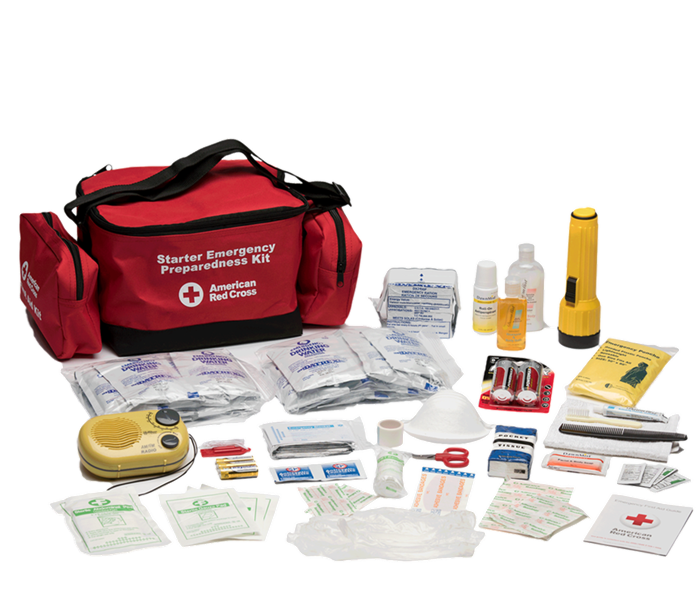 Emergency Preparedness Starter Kit
Emergency Preparedness Starter Kit
After an emergency, you may need to survive on your own for several days. Being prepared means having your own food, water and other supplies to last for at least 72 hours. A disaster supplies kit is a collection of basic items your household may need in the event of an emergency.
Basic Disaster Supplies Kit
To assemble your kit, store items in airtight plastic bags and put your entire disaster supplies kit in one or two easy-to-carry containers such as plastic bins or a duffel bag.
A basic emergency supply kit could include the following recommended items:
- Water - one gallon of water per person per day for at least three days, for drinking and sanitation
- Food - at least a three-day supply of non-perishable food
- Battery-powered or hand crank radio and a NOAA Weather Radio with tone alert
- Flashlight
- First aid kit
- Extra batteries
- Whistle to signal for help
- Dust mask to help filter contaminated air and plastic sheeting and duct tape to shelter-in-place
- Moist towelettes, garbage bags and plastic ties for personal sanitation
- Wrench or pliers to turn off utilities
- Manual can opener for food
- Local maps
- Cell phone with chargers and a backup battery
Consider adding the following items to your emergency supply kit based on your individual needs:
- Prescription medications
- Non-prescription medications such as pain relievers, anti-diarrhea medication, antacids or laxatives
- Glasses and contact lense solution
- Infant formula, bottles, diapers, wipes, diaper rash cream
- Pet food and extra water for your pet
- Cash or traveler's checks
- Important family documents such as copies of insurance policies, identification and bank account records saved electronically or in a waterproof, portable container
- Sleeping bag or warm blanket for each person
- Complete change of clothing appropriate for your climate and sturdy shoes
- Household chlorine bleach and medicine dropper to disinfect water
- Fire extinguisher
- Matches in a waterproof container
- Feminine supplies and personal hygiene items
- Mess kits, paper cups, plates, paper towels and plastic utensils
- Paper and pencil
- Books, games, puzzles or other activities for children
What to do about Basement Flooding?
12/1/2017 (Permalink)
Northwest Chicago, Norridge and Harwood Hts. Residents: We Specialize in Flooded Basement Cleanup and Restoration!
A basement can flood at any time, although flooding most often occurs during heavy rainfall. Basements are inherently prone to flooding because they are the lowest level of a building and are normally built partly or entirely below ground level. There are a number of reasons why your Chicago, Norridge or Harwood Hts.basement could flood, including:
- A blocked or failed sewer lateral pipe
- Heavy rain causes surface water to pool around your home
- Storm sewer backup
- Sanitary sewer backup
- Foundation drainage failure
- Water supply-line break or hot-water tank failure
- And many more
Have Questions about Basement Flooding?
Call Today -708-456-3655
If flood water is not handled quickly and properly, it can jeopardize your health and safety, and cause severe damage to your home’s structure. Remember, the longer you wait, the worse the problem will get.
The bottom line: a flooded basement can jeopardize your health, safety, and your home’s integrity. It’s worth making a call to SERVPRO of Norridge/Harwood Heights and let our trained, professional crews handle the situation safely and correctly. We have earned the trust of hundreds of homeowners, business owners, and property professionals.
We are Flooded Basement Specialists:
- We are Available 24 hours/7 days per week
- We’re a Preferred Vendor to many National Insurance Companies
- We Bill The Insurance Directly – One Less Thing For You To Worry About
- Our Technicians are Highly-Trained in Water Restoration Techniques
- We use s500 IICRC Restoration Standards
- Advanced Inspection and Extraction Equipment
Basement Flooded? Call Us Today – We’re Ready To Help 708-453-3655
IICRC INFO
9/12/2017 (Permalink)
Where does water damage typically come from?
Water can enter the home in a variety of ways, including foundation leaks, burst pipes, appliance valve failures or poor drainage around the home. Burst pipes, valve failures and sewage backups are particularly troublesome, as they can produce several inches of water within hours.
What are the dangers associated with water damage?
When water pools in the home, it will quickly soak through anything it comes in contact with. If it contains contaminants, all organic materials, like textiles and wood, will likely need to be restored. This is because contaminated liquid is the perfect environment for hosting a variety of microbes, including deadly viruses and bacteria. Floods, for example, are typically infested with cholera, hepatitis and other serious diseases.
Mold is also a primary concern when water collects in the home. Mold left unchecked will spread quickly through the home by releasing spores into the air. This means that a mold colony can even reach parts of the house that seem dry. Short term exposure to mold is not typically a major concern, but regular inhalation of mold spores can cause a number of health complications, particularly in the young, old or immune compromised. These complications often include respiratory infections, nausea, agitation, malaise, fatigue, and even deadly neurotoxic complications.
In general, the longer the moisture is allowed to sit in the home, the more problems it will cause. This can result in additional expenses down the road.
How is water damage typically handled by a certified technician?
The first thing professionals will do is remove any compromised materials. This typically includes carpeting, carpet padding, baseboards, insulation, clothing, upholstery, fragile woods like plywood or particle board and gypsum containing materials, like sheetrock walls and ceilings. Once the house is clear of any destroyed items and all standing liquid pumped out, the technicians will work to dry and disinfect the area. This process takes several days, requiring the use of air mover fans, dehumidifiers and, occasionally, heat injection fans.
While the home is drying out, technicians will perform a thorough inspection for mold and other microbes. If the technicians find anything, the microorganisms will be removed and properly treated with disinfectants if needed. When larger mold colonies are present, technicians will build a containment structure around the area and remove the contaminated materials physically.
What kind of training should a water damage restoration company have?
Restoration companies should employ technicians trained by a respected organization like the Institute of Inspection, Cleaning and Restoration Certification (IICRC). The IICRC offers several courses on restoration, including a structural drying course and a microbial remediation course. This training will prepare technicians for a variety of job situations and keep them safe when working around hazardous fluids.
Dry out Your Home EPA
9/12/2017 (Permalink)
Dry Out Your Home Excess moisture in the home is an indoor air quality concern for three reasons: • Microorganisms brought into the home during flooding may present a health hazard. These organisms can penetrate deep into soaked, porous materials and later be released into air or water. Coming in contact with air or water that contains these organisms can make you sick. • High humidity and moist materials provide ideal environments for the excessive growth of microorganisms that are always present in the home. This may result in additional health concerns such as allergic reactions. • Long-term increases in humidity in the home can also foster the growth of dust mites. Dust mites are a major cause of allergic reactions and asthma. Be patient. The drying out process could take several weeks, and growth of microorganisms will continue as long as humidity is high. If the house is not dried out properly, a musty odor, signifying growth of microorganisms can remain long after the flood.
Water Damage Timeline.
12/9/2016 (Permalink)
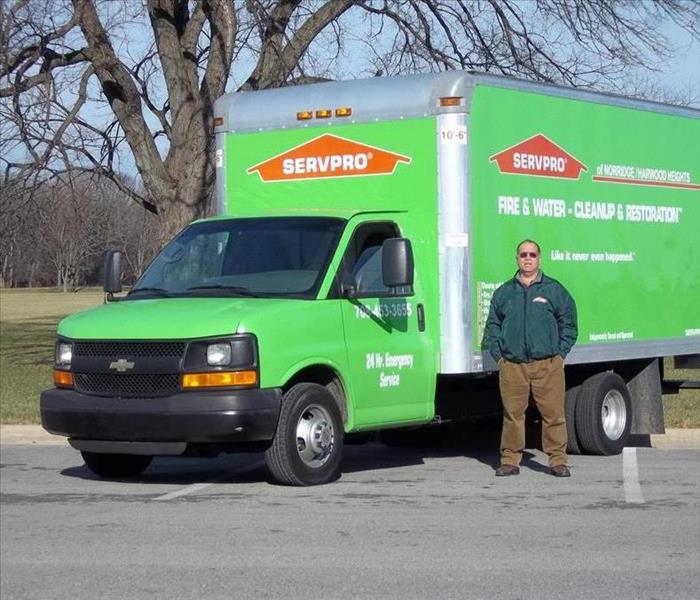 Owner of SERVPRO of Norridge/Harwood Heights
Owner of SERVPRO of Norridge/Harwood Heights
Within Minutes
- Water quickly spreads throughout your property, saturating everything in its path.
- Water is absorbed into walls, floors, upholstery, and belongings.
- Furniture finishes may bleed, causing permanent staining on carpets.
- Photographs, books, and other paper goods start to swell and warp.
Hours 1 - 24:
- Drywall begins to swell and break down.
- Metal surfaces begin to tarnish.
- Furniture begins to swell and crack.
- Dyes and inks from cloth and paper goods spread and stain.
- A musty odor appears.
48 Hours to 1 Week:
- Mold and mildew may grow and spread.
- Doors, windows, and studs swell and warp.
- Metal begins to rust and corrode.
- Furniture warps and shows signs of mold.
- Paint begins to blister.
- Wood flooring swells and warps.
- Serious biohazard contamination is possible.
More Than 1 Week:
- Restoration time and cost increase dramatically; replacing contaminated materials and structural rebuilding may be extensive.
- Structural safety, mold growth, and biohazard
- Structural safety, mold growth, and biohazard contaminants pose serious risks to occupants.
About SERVPRO of Norridge/Harwood Heights
SERVPRO of Norridge/Harwood Heights specializes in the cleanup and restoration of residential and commercial property after a fire, smoke or water damage event. Our staff is highly trained in property damage restoration. From initial and ongoing training at SERVPRO’s corporate training facility to regular IICRC-industry certification, rest assured our staff is equipped with the knowledge to restore your property.
24 Hour Emergency Water Damage Service
11/30/2016 (Permalink)
We Answer the Phone Ready to Help
Call Today - 708-453-3655
We understand that when you call us, you may be feeling confused, stressed, and vulnerable. You need an expert to guide you through this crisis. SERVPRO of Norridge/Harwood Heightshas the specific water damage training and experience to help you through this tough time. We specialize in water damage restoration—in fact, it's the cornerstone of our business.
What to Expect
When you call, we will ask several questions regarding your water damage emergency. These questions will help us determine what equipment and resources to bring, including how many trained SERVPRO Professionals may be needed.
Our SERVPRO Representative will ask several questions:
- Your name and contact information
- Your insurance information (if applicable)
- The street address of the water-damaged home or business
- When did the flooding or water damage occur?
- What caused the water damage (if known)?
- Is there electricity available (on-site)?
About SERVPRO of Norridge/Harwood Heights
SERVPRO of [[Franchise Name]] specializes in the cleanup and restoration of residential and commercial property after a fire, smoke or water damage event. Our staff is highly trained in property damage restoration. From initial and ongoing training at SERVPRO’s corporate training facility to regular IICRC-industry certification, rest assured our staff is equipped with the knowledge to restore your property.





 24/7 Emergency Service
24/7 Emergency Service
